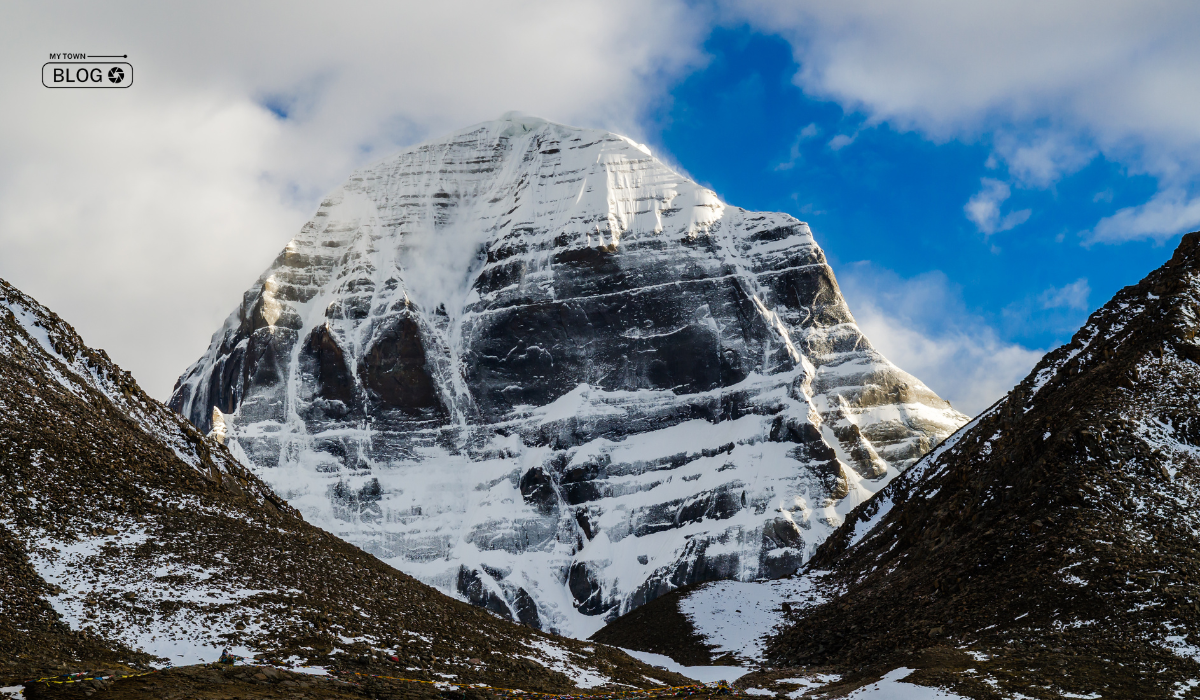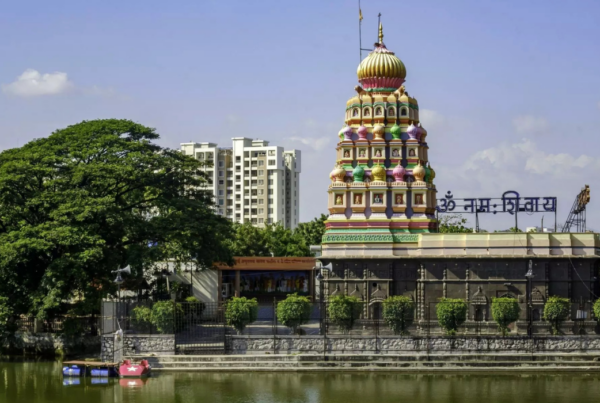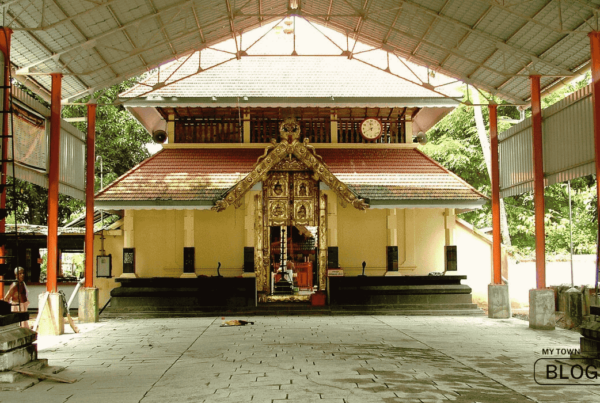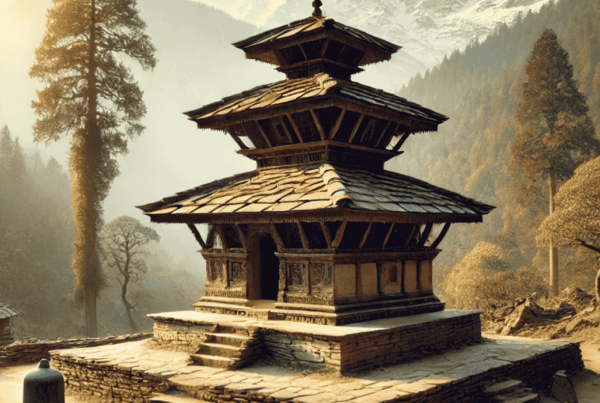Close to Lake Manasarovar, Mount Kailash is revered in Buddhism, Sikhism, Jainism, and Hinduism. It has been stated that Mount Kailash is the home of Lord Shiva. This remarkable site is enveloped in an enigma and is considered a spiritual hub for these religions.
Let’s explore in-depth the voyage, enigmas, past, mythology, and scientific importance of Lake Manasarovar.
History Of Mount Kailash:
Near Lake Manasarovar, according to ancient tales, lies the city of Kubera. According to legend, the holy Ganges, originating from the lotus feet of Lord Vishnu, flows from here down to the peak of Mount Kailash. Lord Shiva then channels these waters into the earth, creating a pure stream. Mount Kailash is depicted as the residence of gods above and the mortal realm below in scriptures like the Shiva Purana, Skanda Purana, and Matsya Purana, particularly in the chapter called “Kailash Khand.”
On Mount Kailash itself, worshippers honor Lord Shiva, symbolizing the connection between heaven and earth. The mountain’s outer perimeter spans 52 kilometers. Lake Manasarovar, often referred to as the “Kshir Sagar” or the Ocean of Milk, lies 40 kilometers from Mount Kailash. According to myth, Vishnu and Lakshmi recline on the serpent Shesha here, governing the universe. Considered a temporary abode of Vishnu, this lake holds significance. Various precious materials like sapphire, crystal, ruby, and gold are associated with different parts of Mount Kailash.
This sacred site holds profound significance in Indian philosophy, reflecting aspects of Indian civilization. At the base of Mount Kailash, there stands a tree said to grant wishes. According to Buddhist legend, a medical tree with fruits that can treat both physical and mental illnesses grows in the middle of the area.
Tibetan beliefs depict a saintly poet dwelling in a cave near Mount Kailash, practicing austerity. According to the Tibetan Bon tradition, Kailash is the home of the nine-storied Swastika, Demchok, and Dorje Phangmo residences. Buddhists revere it as the dwelling place of Lord Buddha and Manjushri, with the divine form of Buddha known as “Demchok” or “Dharmapala” worshipped here. Buddhists believe that visiting this site can lead to Nirvana, and it is said that Lord Buddha’s mother journeyed here.
Jain tradition holds Mount Kailash as the nirvana that of Adinath Rishabhdev, known as “Ashtapad.” According to legend, Rishabhdev ascended to Kailash in eight steps.
For Hindus, Mount Kailash is the abode of Meru Parvat, the axis mundi, and the principal dwelling of Lord Shiva. The belief that it is a Shakti Peeth and that Guru Nanak meditated here increases its importance to Sikhs.
Scientifically Reason of Mount Kailash:
Scientists say that Mount Kailash and Lake Manasarovar, nestled in the Himalayas, are close to the center of the Earth. About 100 million years ago, the Indian subcontinent and Russia collided to form the Himalayan range, which is home to these breathtaking mountains.
Another name for this area is the Axis Mundi, referring to the boundary of heaven and earth and the place where divine forces are thought to merge. Russian scientists studying the area have noted the presence of a unique energy flow around Mount Kailash, where ascetics are said to communicate telepathically with spiritual gurus.
Visitors to Mount Kailash and Lake Manasarovar often report hearing a distinct sound akin to the chanting of “Om” or the beat of a “Damaru.” Scientists attribute this phenomenon to the melting of snow or a combination of light and sound creating a unique atmosphere.
At times, observers have witnessed seven different types of lights shining in the sky over Mount Kailash. NASA scientists speculate that this could be due to the magnetic forces in the region interacting with the atmosphere, producing such remarkable displays.
Local Himalayan residents speak of a humanoid creature dwelling on Mount Kailash, known as the Yeti, Wild Man, or Snowman. Some scientists suggest that it may be connected to the Caveman species. There are many reports from scientists all around the world claiming that Yetis are living in the snowy areas of the Himalayas. It is also stated that the areas are inhabited by the smell of deer, well-known for its strong, medicinal musk.
What is Mount Kailash?
Situated at the center of a hundred lesser pyramids, Mount Kailash forms a massive pyramid that roughly corresponds with each of the four corners of a compass. It rises to a height of 22,068 feet above sea level in the northern part of Tibet, close to the Himalayas, in a lonely region devoid of other famous mountains. Because of its closeness to Lake Manasarovar, which increases its religious significance, Mount Kailash is honored in China even though it is located in Tibet, a territory ruled by China.
Snow-capped peaks border Mount Kailash, soaring to heights of more than 3500 meters. The peak itself is about 22,028 feet high. It is the source of four large rivers: the Indus, the Satluj, the Karnali, and the Brahmaputra. These rivers in turn give rise to other important rivers in China, such as the Ganges and the Saraswati. The four faces of Mount Kailash represent the faces of different animals: the east face represents a horse, the west a big cat, the north a lion, and the south a peacock.
The entrance to the Gate of Yama, which marks the opening of the Kailash Parikrama and the route to Mount Kailash’s interfaces, is located close to Lake Manasarovar. This pilgrimage covers approximately 12 kilometers from the Gate of Yama, with rocky and snowy mountains flanking the path. Around 50 kilometers make up Mount Kailash’s walking around, which travelers often finish in three days. The beautiful lotus-shaped peaks that circle the Kailash top welcome pilgrims along the route. However, Mount Kailash itself remains inaccessible to touch, as it requires climbing a steep ascent of about two and a half kilometers from the pilgrimage route, necessitating specific preparations for mountaineering.
A look into Lake Manasarovar’s past At Mount Kailash:
Rakshastal Lake to the west and Mount Kailash to the north encircle Lake Manasarovar, which is about 320 square kilometers in size.
The name “Lake of the Mind” derives from the Sanskrit terms “Manas” (mind) and “Sarovar” (lake). Legend has it that Mata Parvati once bathed in Lake Manasarovar, and this custom continues to be followed today. Scientists are still unsure about the natural or manmade beginning of these lakes.
Hindu mythology states that Bhagiratha’s penance pleased Lord Shiva, leading to the creation of Lake Manasarovar. According to legend, it is said that this holy lake formed as a result of Lord Shiva releasing water from his Kamandalu (water jar).
Another belief suggests that Lake Manasarovar originated from tears of joy shed by Lord Brahma, which he preserved in his Kamandalu and later released to create the divine lake in the heavenly realm of Triyastakam (Tibet).
According to Shakti texts, the formation of Lake Manasarovar is attributed to the falling of the right palm of Goddess Sati at this location. Consequently, worshippers here venerate a stone representing her as one of the 51 Shakti Peethas.
These myths and beliefs contribute to the spiritual significance and reverence attached to Lake Manasarovar, drawing millions of pilgrims seeking blessings and spiritual enlightenment.
Believers hold that a single dip in Lake Manasarovar can elevate a person to the realm of Rudraloka.
Ancient scriptures describe the lake as the “Ocean of Milk,” surrounded by mountains. According to legend, Maharaja Mandhata discovered Lake Manasarovar and performed years of penance on its shores, nestled at the foothills of these mountains.
Here, There Are Two Main Lakes:
The region comprises two significant lakes: Manasarovar Lake, one of the largest freshwater lakes globally, shaped like the sun, and Rakshas Lake, covering around 225 square kilometers. Rakshas Lake is among the highest saline lakes worldwide, resembling the moon. Together, these lakes embody solar and lunar forces, representing positive and negative energies. When viewed from the south, they form a swastika symbol. North of these lakes lies Mount Kailash, while to the south stands the Gurula mountain range and Gurula peak. In ancient scriptures, the region’s designation as Uttarakhand stems from the presence of Manasarovar Lake.
How should one proceed when starting on a journey?
Usually starting in Kathmandu, Nepal, the trek to Mount Kailash and Mansarovar Lake passes through Uttarakhand, Himachal Pradesh, and Sikkim. It is safest to begin at Sikkim’s Nathu La Pass, which involves walking approximately between ten and fifteen kilometers.
The foreign ministries of India and China jointly organize the journey. The Chinese travel agency plans the trip in Tibet, while the Kumaon Mandal Economic Corporation Limited oversees the path up to the Indian border in India. The 75-kilometer hike from Uttarakhand’s Dharchula to Kailash Mansarovar is especially difficult and dangerous.
The holy trek takes around a month and includes challenging routes because the area’s lakes and peaks are blanketed in snow from October through April. The journey typically takes around 28 to 30 days via the Nepalese route, totaling at least 45 days including departure and return.
Alternatively, travelers can begin the journey from Sikkim by reaching Nathu La Pass. Historical trade route between India and Tibet. But there have been frequent restrictions on this route, most recently following the Doklam stalemate.
The Indian government makes the Kailash Mansarovar Yatra possible through road routes. One option for travelers is to fly into Kathmandu and then drive to Mansarovar Lake. Helicopter services from Kathmandu to Lhasa and then to Shigatse and Gyantse, among other Tibetan towns, are available for reaching Kailash. To get to the endpoint, walking is usually necessary, regardless of where you start.
Best Time to Visit At Mount Kailash:
From May to September, during the summer, is the best time to do the Kailash Mansarovar Yatra. We selected the time for the journey for some reasons, including its suitability.
Weather:
The Kailash Mansarovar region experiences usually warm and pleasant summertime temperatures, ranging from 15°C to 25°C (59°F to 77°F) throughout the day. The cool temperatures make trekking and other outdoor activities more enjoyable. But take in mind that the evenings can still be cool, so it’s necessary to pack warm clothes.
Festivals of Religion:
Other important religious holidays, such as Saga Dawa and Guru Purnima, combine with the Kailash Mansarovar journey in the summer. These celebrations boost travelers’ overall experience by adding to the journey’s cheerful and inspirational atmosphere.
How to Get There Mount Kailash:
Because of its remote location, people frequently need to use different kinds of transportation to reach Mansarovar Yatra. Here are the common routes to reach Mansarovar:
Indian Route:
Road travel from Nepalgunj leads to Hilsa, or Simikot, the border town between China and Nepal. After crossing the border, they travel the yatra’s authorized journey through Taklakot (Purang), Saga, Manasarovar Lake, and finally Mount Kailash.
Route: Kathmandu, Nepal:
- To start your adventure, take a plane to Tribhuvan International Airport in Kathmandu, Nepal, which serves as the starting point for the Mansarovar Yatra.
- Next, you should obtain pilgrimage-related licenses and visas, which you can do through authorized tour operators or travel firms.
- Drive 6 to 8 hours by road from Kathmandu to the border town of Rasuwagadhi, also known as this area, on the Nepal-China border.
- Proceed on your road trip through Kyirong (Gyirong) in Tibet, China after crossing the border.
- Travel along the official yatra path from Kyirong to Saga, then to Manasarovar Lake, and lastly to Mount Kailash.
Bear in mind that obtaining permissions and licenses from the appropriate Chinese and Nepalese authorities is important for traveling on the Mansarovar Yatra. It is advisable to work with authorized tour operators or travel organizations that specialize in planning this pilgrimage. They can help with getting permission, making travel arrangements, and providing direction all along the way.
Please be mindful that the paths and operations could change based on the rules and limitations in place at the moment that the authorities have established. A successful trip to Mansarovar depends on staying up to date. The most recent travel advisories and following the instructions given by the organizing agencies.
Mount Kailash Travel Tips:
Plan in Advance:
The Kailash Mansarovar Yatra is a challenging and physically taxing journey. Obtaining permits, booking hotels, and organizing trip plans all need careful planning, often months in advance.
Physical Fitness:
Physical conditioning is crucial for the journey since it involves traversing high heights and lengthy hikes. Walk, jog, or go trekking as a regular form of exercise and stamina-building tasks before the vacation. You should speak with your doctor for any necessary medical guidance and check-ups.
Acclimatization:
On the Yatra, you’ll ascend to elevations above 5,000 meters (16,400 feet), which increases the risk of altitude sickness. To prevent this, plan a gradual ascent, which will help your body adjust to the reduced oxygen. Take frequent breaks, listen to your body’s signals, and drink lots of water.
Pack Wisely:
Remember to pack the essentials for the journey, like a first aid kit, good trekking shoes, sunscreen, sunglasses, and warm clothing. In addition, pack snacks, energy bars, and water bottles so you can stay hydrated and well-fed during the trip. In case of an emergency, don’t forget to bring copies of your travel documents, permits, and medical records.
Maintain Hydration:
It’s critical to maintain enough water, particularly at high elevations. To stay fresh during the day, sip plenty of water. Ensure that you have access to clean drinking water throughout the trip. It’s also a good idea to pack mobile water filters or tablets for purifying water.
Respect Local Customs and Culture:
Many different religions have sacred importance for the Kailash Mansarovar region. Understanding regional traditions, customs, and places of worship is crucial. Maintain modest clothing and treat other pilgrims and the local community with respect.
Weather Considerations:
The Kailash Mansarovar area experiences erratic weather. To combat important temperature falls, especially at night, pack thick clothing. Carry lightweight and waterproof gear to be ready for rain, snow, and strong winds.
Take it Slow:
There will be physical difficulties during the journey, so you should take it slow. Take scheduled, hike at a comfortable pace, and focus on your body’s signals. Refrain from overexerting oneself as this may lead to fatigue or issues related to altitude.
Travelers’ Insurance:
It is a good idea to have full travel insurance that covers emergency services, trip changes, and medical situations. Make sure your insurance covers high-altitude travel by checking with your provider.
Respect the Environment:
Invest in responsible tourism to help maintain the area’s natural beauty. Be sure to follow established pathways, dispose of waste correctly, and avoid interference with the natural habitat. Be sure that you keep the innocence of the surroundings by leaving the environment untouched.
Also Read: Manimahesh Kailash: History, Lake, How To Reach, And Tracking Tips
Conclusion:
Mount Kailash holds immense cultural, religious, and spiritual significance across various traditions. Its history is steeped in myth and legend, attracting pilgrims and adventurers alike. Scientifically, the region offers unique geological features and challenges, contributing to its allure. Surrounding lakes like Lake Manasarovar add to the mystique of the area. Despite its remote location, reaching Mount Kailash is possible through various means, though the journey often demands dedication and perseverance. Overall, Mount Kailash remains a symbol of reverence and exploration, drawing individuals seeking spiritual enlightenment and natural wonder.








